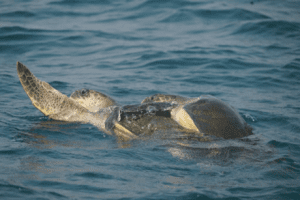TAG: GS 3: ECOLOGY AND ENVIRONMENT
THE CONTEXT: In February, experts anticipate a surge in the number of Olive Ridley turtles choosing the Rushikulya river mouth in Odisha’s Ganjam district for mass nesting.
EXPLANATION:
- The beach’s optimal condition and favorable climatic conditions contribute to this expectation, marking it as a crucial rookery for the endangered species.
- Secretary of Ganjam’s Sea Turtle Protection Committee predicts an early mass nesting in the third week of February due to the absence of adverse weather conditions.
- Fishing is prohibited within a 20 km radius of the nesting site from November 1 to May 31 to safeguard the turtles during their congregation.
Factors Contributing to Nesting:
- Favorable Climate and Beach Preservation:
- The Rushikulya river mouth is a major rookery, and this year, a higher number of Olive Ridley turtles are expected due to the favorable climatic conditions.
- Senior scientist notes that the well-preserved beach is a key factor in attracting turtles.
- Visible mating conditions among Olive Ridleys in the Bay of Bengal further indicates a conducive climate.
- Previous Records and Expert Opinions:
- In 2023, a record-breaking 637,000 turtles laid eggs during an eight-day mass nesting period.
Conservation Efforts:
- Tagging and Monitoring:
- In collaboration with the state forest department, the Zoological Survey of India (ZSI) has tagged over 12,000 turtles in the last three years.
- Despite conservation efforts, two tagged Olive Ridley turtles were found dead in December and January, emphasizing the need for ongoing monitoring.
- Site Protection Measures:
- The mass nesting site is corralled with green fencing to minimize disturbances, and visitors are restricted from accessing the area.
- Nine protection units, including boats and personnel from various departments, are deployed to safeguard the nesting site.
- Flood Impact on Nesting Sites:
- The absence of floods raises concerns about the presence of biomass, including hatched egg shells from the previous season, which may affect the nesting sites.
- Pandav suggests that floods are necessary to clean the nesting sites and ensure a suitable environment.
Olive Ridley turtles:
- The Olive ridley turtles are the smallest and most abundant of all sea turtles found in the world.
- They are found to be inhabiting the warm waters of the Pacific, Atlantic, and Indian oceans.
- They are carnivores and feed mainly on jellyfish, shrimp, snails, crabs, molluscs, and a variety of fish and their eggs.
- The males and females grow to the same size.
- These turtles, along with their cousin the Kemps ridley turtle, are best known for their unique mass nesting called Arribada, where thousands of females come together on the same beach to lay eggs.
- The coast of Orissa in India is the largest mass nesting site for the Olive-ridley, followed by the coasts of Mexico and Costa Rica.
- The species is recognized as Vulnerable by the IUCN Red list.
- They lie in Scheduled 1 of the Wildlife Protection Act, 1972
- They are in Appendix I of the CITES.

Conclusion:
- The combination of favorable climatic conditions, conservation efforts, and protective measures by the government bodes well for the anticipated increase in Olive Ridley turtles choosing the Rushikulya river mouth for mass nesting in the upcoming season.
- Continued vigilance and conservation actions are essential for the long-term preservation of this endangered species.

